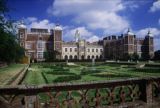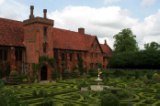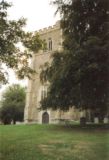Hatfield, Hertfordshire
Hatfield, Hertfordshire – History in Reverse
This continues my quest to discover a Ricardian or Yorkist connection to places in Hertfordshire. Hatfield was fairly high on my agenda as I spent a year as a foreign language assistant teaching German at two schools, one of which was in Hatfield, in 1980/81.
After arriving on a Saturday evening in late August 1980, our first visit the next day was to Hatfield House. As the first thing you see is the latest building on the site, this story will be going chronologically backwards.
1. The Modern Hatfield House

The modern Hatfield House (Photograph taken by Allan Engelhardt; obtained through Wikimedia Commons.)
This “modern” palace was only built between 1608 and 1611 by Robert Cecil, 1st Earl of Salisbury and Chief Minister to King James I (1). It has been assumed that Shakespeare’s Richard III was modelled on Robert Cecil (2), though to count this as a Ricardian connection would be rather far-fetched.
This House is most impressive, for me the grand staircase, complete with flap doors at the bottom to prevent dogs from getting upstairs, and the long gallery were especially interesting. There are also beautiful stained glass windows in the chapel.
The Hatfield House of today replaced an earlier building, the remains of which are referred to as the Old Palace. In the early 17th century, the Hatfield property belonged to the crown, but James I did not like it and was rather envious of Robert Cecil’s Theobalds (near Cheshunt, Herts) and suggested an exchange. Cecil agreed, but it seems he was not impressed with the Old Palace either and pulled down three sides and started building the present House, which cost him at least £38,000. He even established a walled vineyard in the park, though he never enjoyed any home-grown cabernet, as there is no evidence that even a single bottle of wine was ever produced. Nor did Robert Cecil ever get to enjoy is new home, he died in 1612, just before it was completed. However, the House still belongs to the family and is now the home of the 7th Marquess and Marchioness of Salisbury.
Obviously this House is too new to have any connection with Richard III and his family. Though this year you might have been forgiven for thinking otherwise: a British sculpture exhibition was presented in the gardens which included works by Terrence Coventry, featuring among other items ‘Boar II’ and ‘Sitting Boar’ [3].
2. The Old Palace
So let us go further back in history and look at the Old Palace. Before Robert Cecil exchanged the property for Theobalds it had belonged for 70 years to the crown and before that to the Bishops of Ely.
The Old Palace was built by one Bishop of Ely, who is well-known though not well-liked by Ricardians: John Morton. The VCH says that he rebuilt a former building in the 1480s [4], presumably some time between 1480 and 1486, when he became Archbishop of Canterbury. Though he would have been absent from any supervisory role for about 2 years considering that he spent the best part of Richard III’s reign abroad.
This Hatfield Palace was a big quadrangle of russet brick [5], with stair towers in the internal angles of the central court and a principal entrance in the centre of the outer eastern face. Most of this building was demolished to make place for the present Hatfield House, only the former west wing remains, which contained the great hall, solar, kitchen and butteries. A plan of this building survives. The great hall is these days used for medievally themes banquets [6].
The Old Palace has strong connections with the children of Henry VIII and especially with Elizabeth, who spent much of her childhood and youth here [7]. In 1549 Edward VI had wanted to give the manor to John Earl of Warwick, but Elizabeth had liked it so much that she petitioned against it. The Earl of Warwick returned it to the king, who gave it to his sister Elizabeth, who made it up to the Earl by giving him other lands.
According to tradition Elizabeth was sitting under an oak tree in the park, reading, when news reached her that Mary had died and she would be queen. Her first three councils were held here in Hatfield, and later she returned frequently [8].
Before Elizabeth, her father, Henry VIII, had spent a fair amount of time at Hatfield and had apparently liked the property, so he kept it after the dispersal of church properties [9].
3. Hatfield before Morton
Contrary to what Hatfield House tells us [10], the history of Hatfield Palace does not begin with Morton. It goes back another 500 years, to when King Edgar gave the property c.970 to the Abbots of Ely [11]. Later, the Abbot became the Bishop of Ely. A brother of Ely says the king gave them the well-wooded land in Hatfield, so that “the brothers would be able to have timber from it for the building of the church and enough firewood to satisfy their needs”. Probably necessary considering that Ely lies like an island in a very marshy area. After King Edgar’s death there was a dispute about his right to grant the land to the monastery, and the monks eventually had to buy it back as they did have no other woodland [12].
The Bishops of Ely had had for a long time a house in Hatfield, where they often received royal visitors, among them King John, Edward I, II and III. The connection to the Bishops of Ely also explains the name of the parish Church of Old Hatfield, St Ethelreda, which was built in the 13th century. Incidentally, Ethelreda is the same as Audrey, and there used to be a St Audrey’s School in Hatfield, which is now combined with one of the schools I worked at to become Onslow St Audrey’s School, a school of which I have very fond memories. The Onslows were a prominent family in the area.
Unfortunately we do not know when the Bishops of Ely first built a house at Hatfield. We do know however, that by 1292 a fairly substantial building existed, which was then enlarged further [13].
It would be in this building that Jasper Tudor or Jasper of Hatfield was born in c.1431. He was uncle and mentor to Henry Tudor [14].
It has sometimes been said that a son of Edward III, William of Hatfield, was born here in 1337 [15], but it seems more likely that this was actually Hatfield in Yorkshire. Hatfield Chase in Yorkshire had been a Crown property from 1346 until the reign of Charles I [16]. In a wide variety of sources this is also stated as the birthplace of William of Hatfield, and the fact that his mother gave a thank-offering to the neighbouring Roche Abbey on the occasion indicates that the Yorkshire Hatfield is more likely [17].
4. A Yorkist Hatfield?
However, it is possible that Hatfield is not only connected to Richard’s enemies like Jasper Tudor and John Morton, but also to his family directly. Richard had an older brother, Henry of Hatfield, who was born on 10 February 1441, but died young [18]. As the name indicates this Henry was born in Hatfield, but as with William of Hatfield there is some controversy regarding which Hatfield.
Alison Weir states that he was born in Hatfield in Hertfordshire [19]. Michael Jones, however, is of the opinion that it was at Hatfield Chase in Yorkshire, arguing that this was a York family residence [20]. So, Hatfield – yes, but which one?
For Hatfield, Herts., speaks that if Katherine de Valois gave birth to Jasper Tudor at the Hertfordshire Hatfield, then it is equally possible that Cecily Neville gave birth there to a a son Henry. The facilities would have been quite comfortable. In addition Hatfield is situated on the Great North Road, so it might very well have been a convenient rest stop on the way North.
Against ‘our’ Hatfield we have to keep in mind that it had been known as “Bishop’s Hatfield” since 1108 [21]. And the local historical site for the Hertfordshire Hatfield does not claim any connection to Henry of Hatfield [22], while the one for the Yorkshire one does [23], though this hardly constitutes proof.
While I am not in a position to decide one way or the other, I regret to say that I tend more towards the Yorkshire Hatfield. It seems I’m not the only one who is not sure: I had asked historian John Ashdown-Hill (author of The Last Days of Richard III) whether he could help me further. He was not sure either, but indicated that the feeling amongst the research sub-committee of Richard III Society is that Henry was born in the Yorkshire Hatfield [24].
In addition to the dubious Henry (as far as his place of birth is concerned), the Wikipedia entry on Cecily of York (daughter of Edward IV and Elizabeth Woodville) gives us the tantalising hint that “Horrox disputes [that Cecily is buried in obscurity in Quarr Abbey on the Isle of Wight] pointing to evidence from the Beaufort account books that states she died at Hatfield, Hertfordshire, after a three-week sojourn there, and was buried at a place that must have been local, known as ‘the friars’ (perhaps the friary at Kings Langley, associated with the House of York and where Edmund of Langley, 1st Duke of York was buried)” [25]. Unfortunately it is not clear where Rosemary Horrox is supposed to have disputed this, so I have not been able to follow up on it.
While we have strong links to the Lancastrian/Tudor side of late medieval English politics, the claims for Yorkist links remain unfortunately much more controversial.
Notes:
1. Rowe, p. 113
2. Delahoyde
3. Hatfield House. Photographs of the sculptures from this exhibition can be found on Flickr. Terence Coventry is a pig farmer which explains his choice of subject. For more information on Terence Coventry: David Cornwell, “Natural Born Sculptor”, The Times, 7 April 2007, accessed 9 November 2010
4. VCH
5. VCH
6. Hatfield House
7. Hatfield House
8. VCH. When I first visited in 1980 you could still admire the orginal oak tree, though it seems that it had to be replaced in the meantime (Hatfield House).
9. VCH
10. “The history of Hatfield House begins in about 1485, when John Morton, Bishop of Ely, built Hatfield Palace.” (Hatfield House). Also: “As far as I know there was no building here before the Old Palace.” (private communication by Vicki Perry, Assistant Archivist, Library and Archives, Hatfield House, dated 22 January 2010)
11. “An Outline History of Hatfield”. The see of Ely has quite an interesting history: Ely was part of the patrimony of Saint Etheldreda, a daughter of an Anglian king in 649. She later founded a monastery, which she endowed with lands in Ely. The monastery was led by four abbesses, who all became saints: Ethelrada, her sister Sexburga, the latter’s daughter Ermenilda, and Ermenilda’s daughter Werburgh. It was at this time a community of monks as well as nuns. However, the monastery was destroyed by the Danes in 870 and restored in 970 by King Edgar, but then it was no more women’s equality and it was monks only. In 1109 the new Diocese of Ely was created and the monastery became the cathedral and the abbots became bishops. (“Bishop of Ely”, Wikipedia, accessed 5 July 2010)
12. Rowe, p.108, quoting J Fairweather, Liber Elensis translated from the Latin, Woodbridge, 2005, pp.103-104. The story is also, with more detail, in VCH.
13. VCH
14. Stewart
15. “Edward III, King of England”
16. Heinze, fn. 11, p.181
17. Thorne, p.327
18. “Henry of York”
19. Weir, p.134. A wide variety of sources on the internet quote Ms Weir unquestioningly, as incidentally did the archivist at Hatfield House in the above-mentioned communication.
20. Jones, p.81
21. Lewis, p.337
22. “An Outline History of Hatfield”
23. Hatfield Town Council, ‘Parish History‘
24, Private communication by John Ashdown-Hill dated 8 February 2010
25. “Cecily of York”
Bibliography:
Michael Delahoyde, “Richard III”. Washington State University, Fall 2010. URL: http://www.wsu.edu:8001/~delahoyd/shakespeare/richardIII.5.html, accessed 30 November 2009
Rudolph W Heinze, The Proclamations of the Tudor Kings. CUP Archive, 1976. ISBN 978 0521209382
Michael L Jones, Psychology of a Battle – Bosworth 1485. Tempus Publishing, Stroud, 2003. ISBN 0 7524 2594 3
Samuel Lewis, A Topographical Dictionary of England. Vol.2, London, 1831, pp.337-338
Anne Rowe, Medieval Parks of Hertfordshire. University of Hertfordshire Press, Hatfield, 2009. ISBN 979 1 905313 48 8.
RB Stewart, ”Jasper of Hatfield, Earl of Pembroke, Duke of Bedford”, My Lines. URL: http://homepages.rootsweb.ancestry.com/~cousin/html/p435.htm, accessed 16 January 2010
James Thorne, Handbook to the Environs of London. BiblioBazaar, LLC, 2008. ISBN 978 0559244117
Victoria County History (VCH), “Parishes: Hatfield”, A History of the County of Hertford: volume 3 (1912), pp. 91-111. URL: http://www.british-history.ac.uk/report.aspx?compid=43587, accessed 27 January 2010
Alison Weir, Britain’s Royal Families – The Complete Genealogy. Pimlico, London, 1996, ISBN: 0712674489
Online:
“Cecily of York”, Wkipedia. URL: http://en.wikipedia.org/wiki/Cecily_of_York, accessed 15 January 2010
“Edward III, King of England”, The Peerage.com. URL: http://thepeerage.com/p10188.htm, accessed 9 November 2010
“Henry of York”, The Peerage.com. URL: http://www.thepeerage.com/p10497.htm#i104965, accessed 23 January 2010
Hatfield House. URL: http://www.hatfield-house.co.uk, accessed 9 November 2010
“An Outline History of Hatfield”, The Unofficial Website for Hatfield, Hertfordshire, UK. URL: http://www.hatfield-herts.co.uk/history.html, accessed 6 June 2010
Tags: Church, Family, Hertfordshire, Yorkshire




[…] died at Theobalds House, which as we have seen he had exchanged for Hatfield House, on 27 March […]
[…] Charles I gave Hertford Castle to William Cecil, 2nd Earl of Salisbury, who also owned Hatfield House. The family owns it to this day, but leased it to Hertford Corporation in 1911 for a nominal […]
[…] investigating possible Yorkist links to Hatfield, Herts I was interested to see whether Cecily’s son Henry would be born in Hertfordshire or Yorkshire. […]
[…] For more on the discussion which Hatfield, see here. […]
[…] son of Owen Tudor and Catherine of Valois, the widow of Henry V. He was born in approx. 1451 at Bishops Hatfield, Herts, which belonged to the Bishops of […]
[…] spent part of her youth at Hatfield House, Herts., where she was residing when her sister, Queen Mary, died on 17 November 1558. She would reign […]
[…] died on 24 August 1507 at Hatfield, […]